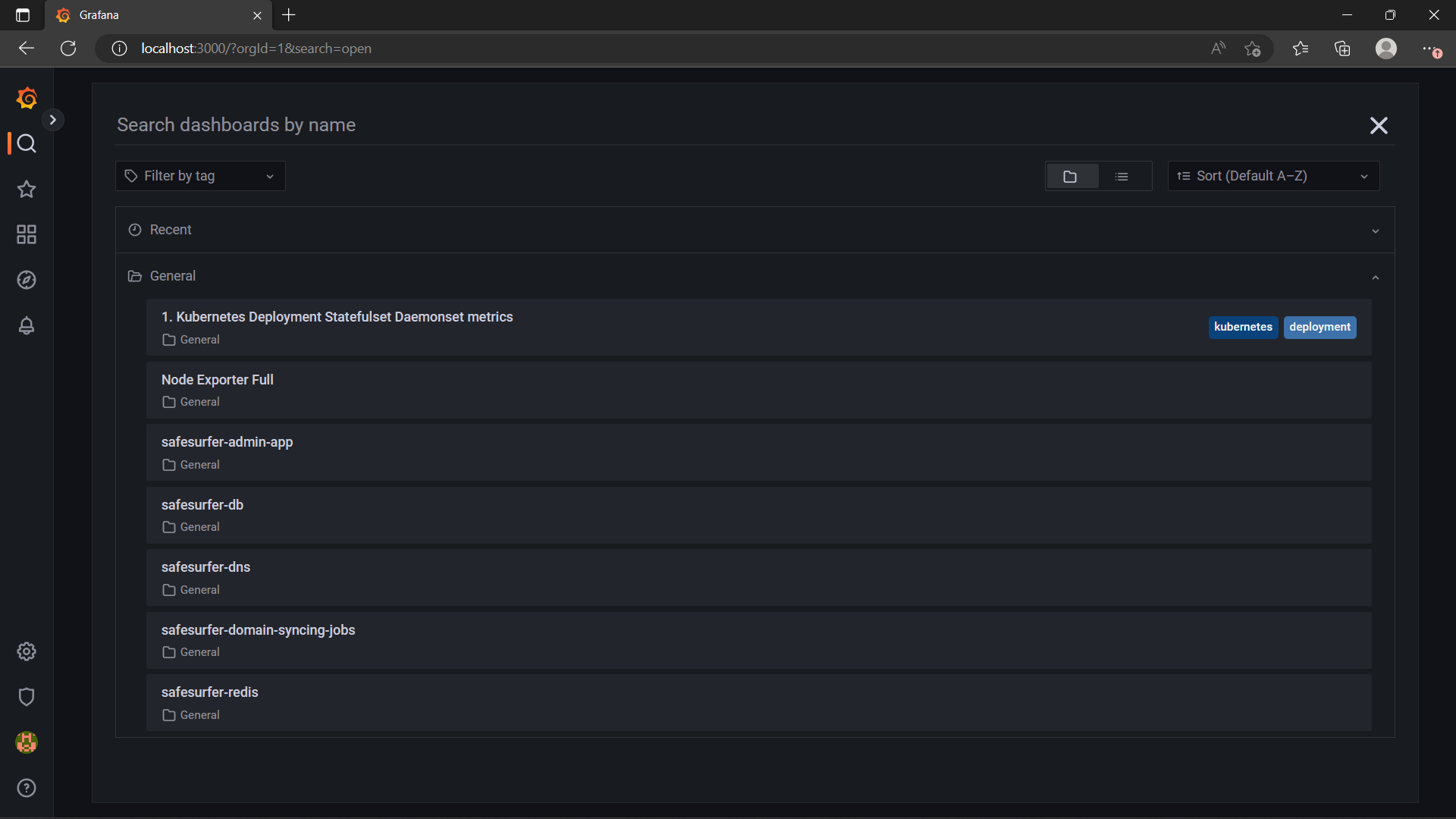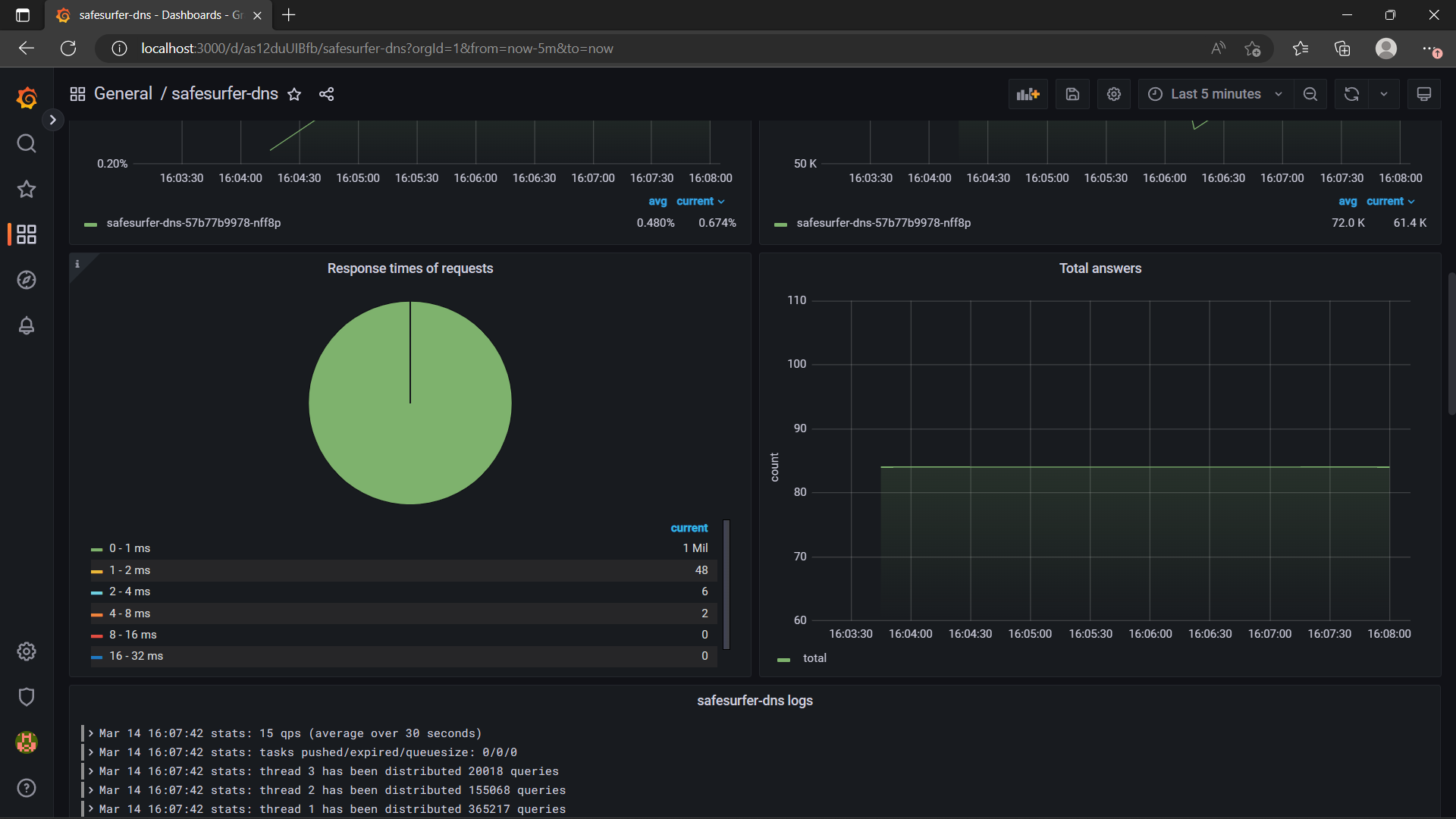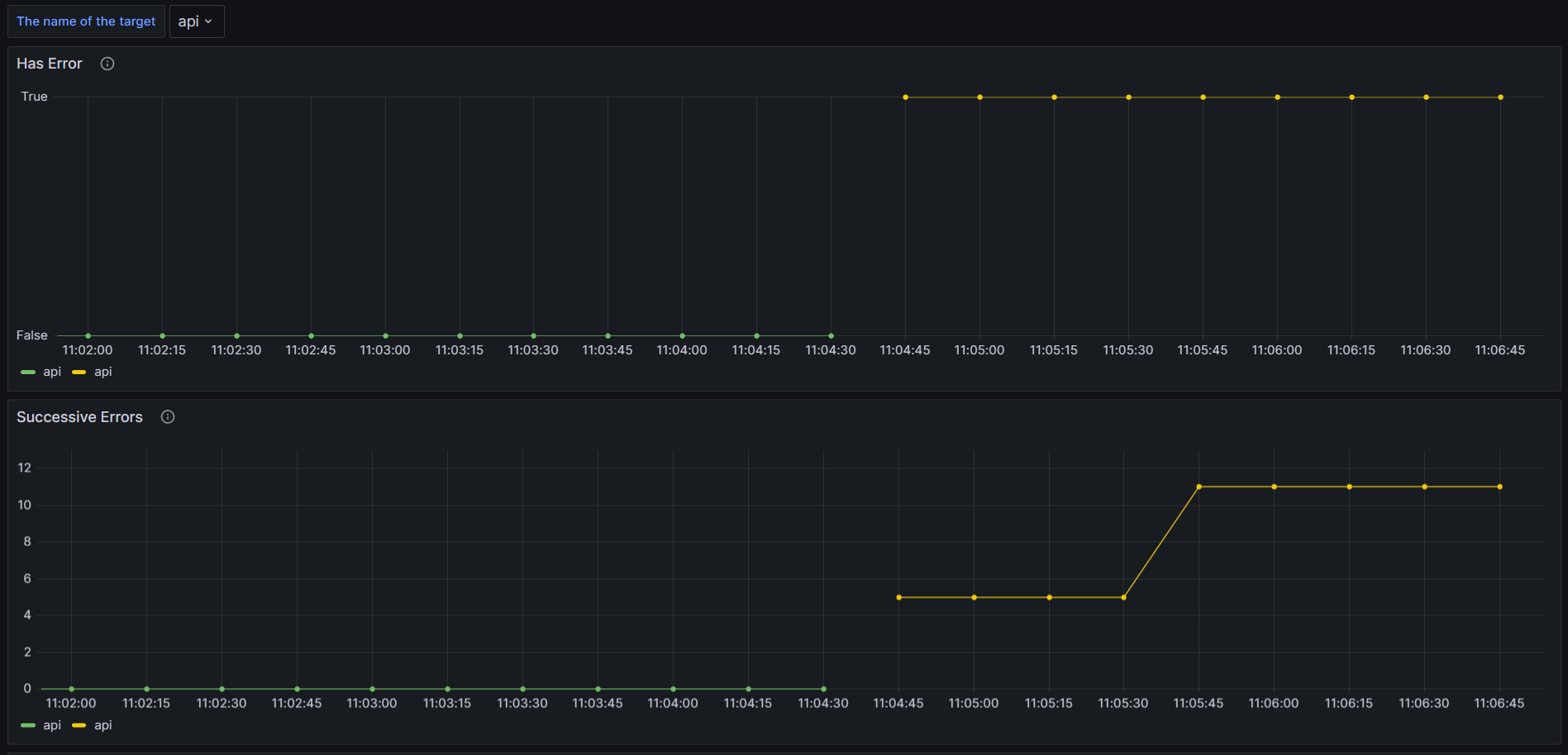Core
Monitoring
This chart comes packaged with Grafana dashboards that you can use to observe the deployments. Grafana pulls data from the Prometheus and Loki databases. You can also set up alerts using Prometheus. As part of this guide, we’ll install the above tools in the cluster and enable the Safe Surfer dashboards. You can complete this guide at any point during the other guides, or not at all.
Installing the tools
See the Monitoring Stack repo for how to install the tools. They may already be installed in your cluster, in which case you don’t need to do anything.
Enabling the dashboards
Warning With this setup, the monitoring tools are installed into the
monitoringdirectory. The dashboards will also be installed into themonitoringdirectory, not the--namespacethat you provide to Helm. You can change this behavior by leavingmonitoring.namespaceblank and deploying grafana to your release’s namespace.
Add the following to your values.yaml:
monitoring:
enabled: true
namespace: monitoring
Then, upgrade your deployment:
helm upgrade "safesurfer" "safesurfer/safesurfer" -f values.yaml
Grafana should now be loaded with the dashboards. The instructions linked above show how to access grafana using port-forwarding, but you can also enable an ingress for convenience under monitoring.ingress. See ingress and cert setup for more details.
After accessing Grafana through either method, you should now see a few useful dashboards in the General folder:

The safesurfer- dashboards monitor the Safe Surfer deployments specifically, while the others added by Grafana are useful for monitoring the cluster in general.
New dashboards are automatically added as you enable parts of the chart. For example, if you’ve enabled the DNS on kubernetes, the DNS dashboard will show some useful performance and resource usage information:

Troubleshooting
- If you’ve deployed the monitoring stack to the monitoring namespace (as this example shows), the tls configuration may not work as you expect, since the ingress will also be created in the
monitoringnamespace. Therefore, you cannot reference a secret created in the release namespace.
Alerting
You can use prometheus alerts to alert for any metrics in the cluster. A useful deployment for this is healthChecks, which generates prometheus metrics for uptime checks that you define. A Grafana dashboard also visualizes the status over time. To try it out, add the following to your values.yaml, updating the URLs/addresses to point to your own deployment:
healthChecks:
enabled: true
spec:
targets:
# Comment out targets for anything you haven't created yet
# HTTP health checks are useful for checking whether the API is running properly.
- name: api
interval: '*/10 * * * * *' # Every 10 seconds
healthChecks:
- type: HTTP
spec:
url: https://api.ss.example.com
method: GET
timeout: 5s
# DNS health checks for whether the DNS is functioning properly.
# Health checks for secure DNS are also available, see the full values.yaml
# file for all examples.
- name: plain-dns
interval: '*/5 * * * * *' # Every 5 seconds
healthChecks:
- type: DNS
spec:
address: '0.0.0.0' # DNS resolver to query
port: 53 # 53 is default
proto: udp # udp is default
domain: internetbadguys.com # domain to look up
expectedIPs: # If specified, assert that certain IPs must be returned.
- '0.0.0.0'
timeout: 2s
# Also test ipv6 - or comment out if you're not using ipv6
- type: DNS
spec:
address: '[0::0]' # IPv6 must be in square brackets
proto: tcp
domain: google.com
timeout: 5s
Then, upgrade the deployment. You should now see the health checks pod:
NAME READY STATUS RESTARTS AGE
safesurfer-health-checks-668c9fb88d-gkb9g 1/1 Running 0 116s
There should also be a new Grafana dashboard named safesurfer-health-checks, which shows whether your targets are currently healthy, how many successive failures they have, and the logs, which show why they fail. All going well, it should look something like this:

To actually get alerted, we’ll need to update our prometheus deployment. Create a file named prometheus-values.yaml, and adapt the following snippet. Prometheus doesn’t alert you on its own, but can be configured to work with a large number of alerting providers. The receivers array is where you define this. For the possible configurations, see the prometheus docs.
server:
resources:
limits:
cpu: 500m
memory: 1500Mi
requests:
cpu: 100m
memory: 1500Mi
serverFiles:
alerting_rules.yml:
groups:
- name: dns
rules:
# Alert for any target that is unhealthy 6 times in a row. This would equate to being down for a minute
# if the health check runs every 10 seconds.
- alert: TargetFrequentlyUnhealthy
expr: ss_status_successive_errors > 5
for: 0m
labels:
severity: critical
annotations:
summary: "Target unhealthy"
description: " has been unhealthy for the last checks"
# Alert if the health check pod is down for more than a minute
- alert: MonitoringProblem
expr: absent(ss_status_is_error)
for: 1m
labels:
severity: critical
annotations:
summary: "Health check not found"
description: "No health check update for 1 minute"
alertmanager:
config:
route:
receiver: safesurfer-team
continue: false
group_wait: 10s
group_interval: 5m
repeat_interval: 1h
receivers:
## Define your receivers here:
# - name: safesurfer-team
# opsgenie_configs:
# - api_key: example-api-key
Then upgrade your prometheus deployment. This depends on how you’ve deployed it, but according to the monitoring stack repo instructions it would be helm -n monitoring upgrade prometheus prometheus-community/prometheus -f prometheus-values.yaml.
To test our alerting system, we’ll have to break something! Update your values.yaml to create a health check that won’t succeed. For example, modify the URL/address; then upgrade the deployment. We should now see something like this on the Grafana health checks dashboard:

Your chosen alerting system should now be alerting you.
Troubleshooting
- Not being alerted? Check prometheus server and alert manager logs for issues with prometheus configuration.
Creating a status page
You can expose the current health status for your targets publicly over HTTP, which is useful for creating an automated status page. To do this, enable the http section and configure the ingress:
healthChecks:
http:
enabled: true
ingress:
enabled: true
host: status.ss.example.com
tls:
http01: true
# Or other TLS config
After the certificate and ingress are ready, you can query the current status of particular targets:
$ curl https://status.ss.example.com/healthy?target=api
false
This API will return true or false for whether the target is currently healthy. If unhealthy, it will return a status code of 500, allowing it to be used in place of services that expect to query a URL directly. If healthy, it will return a status code of 200. In the above example, it’s unhealthy, because we’ve deliberately made is so in the previous example. If we update our health check to succeed again, we’ll get a response like this:
$ curl https://status.ss.example.com/healthy?target=api
true
Common monitoring tasks
API Abuse
Using the Loki API, you can check if a particular IP addresses are spamming a particular API endpoint, or the API in general. This may be accidental, or deliberate abuse such as a DDOS attempt or password cracking.
Note The API includes built-in protection against password cracking if you set up
api.accounts.forceEmailOtpOnUnknownIpField, since the auth endpoint will always return a 200 status code and an email OTP ID when the request is from an unknown IP address, city, or region.
To start off, set some variables:
# The route of the API endpoint you want to query, or blank for all
ROUTE="/v2/user/auth/token"
# The namespace of your deployment
NAMESPACE="default"
# The name of your helm release
RELEASE_NAME="safesurfer"
# Unix timestamp of the earliest time you want to query. You will have to generate this.
START_TIME=""
# Max amount of logs to return. 5000 is the maximum you can query from loki by default.
LIMIT="5000"
Then, port-forward loki in a separate terminal. The command for the default installation would look like this:
$ kubectl -n monitoring port-forward svc/loki 3100:3100
Forwarding from 127.0.0.1:3100 -> 3100
Forwarding from [::1]:3100 -> 3100
Then, run the query and save it to a temporary file:
QUERY_PARAM=$(printf "{app=\"${RELEASE_NAME}-api\", namespace=\"${NAMESPACE}\"} |= \"${ROUTE}\"" | jq -sRr @uri)
curl "http://localhost:3100/loki/api/v1/query_range?start=$START_TIME&limit=$LIMIT&query=$QUERY_PARAM" > /tmp/ss-query.json
Then, generate a histogram of the results:
cat /tmp/ss-query.json | jq '.data.result[].values[][1]' | rev | cut -d ' ' -f1 | rev | sed 's/[\\"]//g' | sort | uniq -c
The result will look something like this, where the number on the left is the amount of times the IP address requested that API endpoint:
1 xx.xxx.xxx.xxx
15 xx.xxx.xxx.xxx